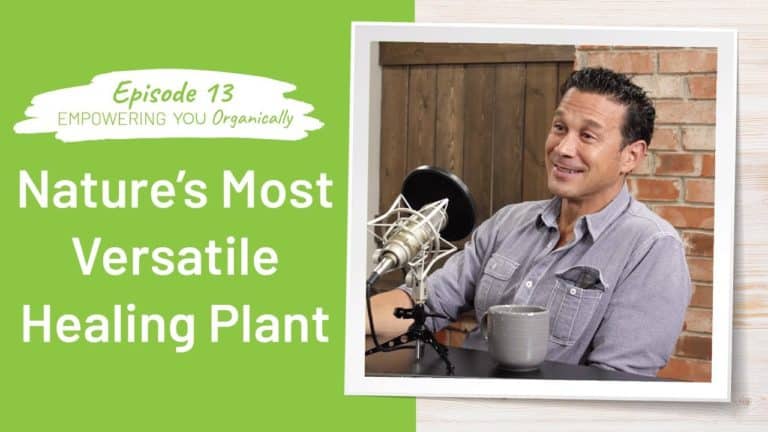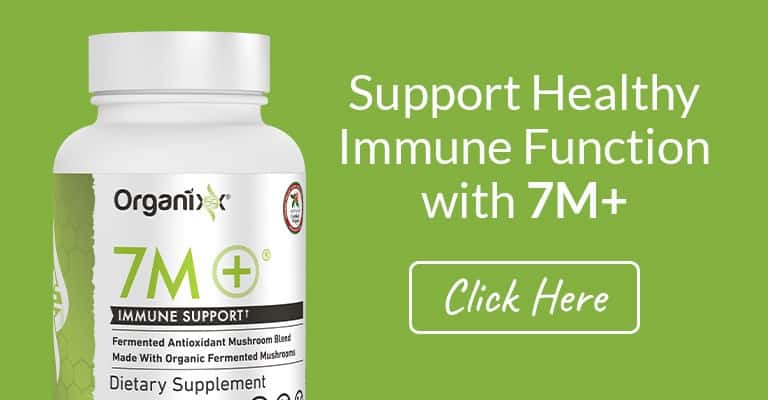Empowering you Organically – Season 2 – Episode 13
Title: Understanding the Healing Power of Cannabis
Hosts: Jonathan Hunsaker & TeriAnn Trevenen
Guest: John Malanca
Description: In this episode, we talk with John Malanca about cannabis! We tackle topics like, what is cannabis, how it used medically, the difference between THC and CBD, and much more!
*****
Fact: Most cancer patients do not die from cancer, but malnutrition.
John’s Introduction into Medical Cannabis
- In 2011, father-in-law was battling stage 4 lung cancer, couldn’t eat, and was on oxygen 24/7.
- Doctor gave him two weeks to live.
- Started using a coconut oil capsule infused with raw and heated cannabis.
- Within 24 hours he was eating, by day 8 he was walking around the house.
- At the 3 month mark, switched to a full extract cannabis oil – administering a minute amount in the evening.
- Within 6 months he was walking, driving, and Hospice fired him as a patient!
- By the 9th month he had the first scan to show, “No evidence of recurrent disease.”
- After 17 lung and brain scans showing no evidence of recurrent disease! He is still healthy and happy today – 8 years later!
United Patients Group
- Founded by John and Corrine Malanca to fill the information void surrounding medical cannabis.
- Don’t sell products – strictly education and information.
- Teach local, state, international governments, as well as local, state and international medical institutions about medical cannabis.
- All courses are CME approved continuing medical education.
What is cannabis?
Cannabis (/ˈkænəbɪs/) is a genus of flowering plants in the family Cannabaceae.
- Also known as Hemp if less than .03% THC in the composition of the plant
Three species may be recognized:
- Cannabis Sativa – formulations that include more uplifting, “day time” feelings
- Cannabis Indica – formulations that include more sedative and relaxing effects, including pain reduction
- Cannabis Ruderalis – (not discussed in the interview) naturally low concentrations of THC occurring, more research is being done on this variation of the species
- Cannabis Hybrid – formulations that are mixes of Sativa and Indica based plants made from crossbreeding
- There are currently 483 known compounds in the plant.
- The main psychoactive part of cannabis is tetrahydrocannabinol (THC). Although this is the main psychoactive components of the plant, it is also one of the main cannabinoids needed and used in medical treatments when Cannabis is on the protocol.
- Contains at least 113 cannabinoids
Two Known Subtypes of Cannabinoid Receptors
First discovered in the 1980s. Located throughout the body. Part of the endocannabinoid system, which is involved in a variety of physiological processes including appetite, pain-sensation, mood, and memory, and more that have since been researched. These receptors are all over our body, head to toe.
- The CB1 receptor is expressed mainly in the brain (central nervous system or “CNS”), but also in the lungs, liver and kidneys.
- These receptors are thought to be one of the most widely expressed Gαi protein-coupled receptors in the brain
- The CB2 receptor is expressed mainly in the immune system and in hematopoietic cells.
- These receptors are mainly expressed on T cells of the immune system, on macrophages and B cells, and in hematopoietic cells.
- They also have a function in keratinocytes.
- They are also expressed on peripheral nerve terminals. These receptors play a role in antinociception, or the relief of pain.
What are Cannabinoids?
A cannabinoid is one of a class of diverse chemical compounds that acts on cannabinoid receptors in cells that alter neurotransmitter release in the brain.
- 113 cannabinoids have been isolated from the Cannabis plant.
- Research shows the effect of cannabinoids might be modulated by aromatic compounds produced by the cannabis plant, called terpenes as well as by the other cannabinoids.
- This interaction would lead to the entourage effect.
Medical Uses
Medical cannabis (or medical marijuana) refers to the use of cannabis and its constituent cannabinoids, as well as terpenes, to treat disease or improve symptoms relief.
- reduce nausea and vomiting during chemotherapy
- improve appetite in people with HIV/AIDS or cancer
- treat chronic pain and muscle spasms (MS and other nerve related pain)
- lessens tremors in Parkinson’s Disease
- control seizures
- reduce pain of cluster headaches in minutes
- cannabinoids are under preliminary research for their potential to affect stroke
- THC has been shown to kill cancer cells
- CBD has been shown to stop cancer cells and prevent the spread
- Many more!
Delivery Systems – Ways to Consume Medical Cannabis
- Sublingual absorption
- Topical
- Vaporization
- Suppositories
- Transdermal patches
- Edibles
Interesting Statistics
- This statistic presents the percentage of U.S. adults who would recommend medical cannabis to their friends as of January 2017. It was found that 62 percent of respondents aged between 18 and 34 years were likely to recommend cannabis.
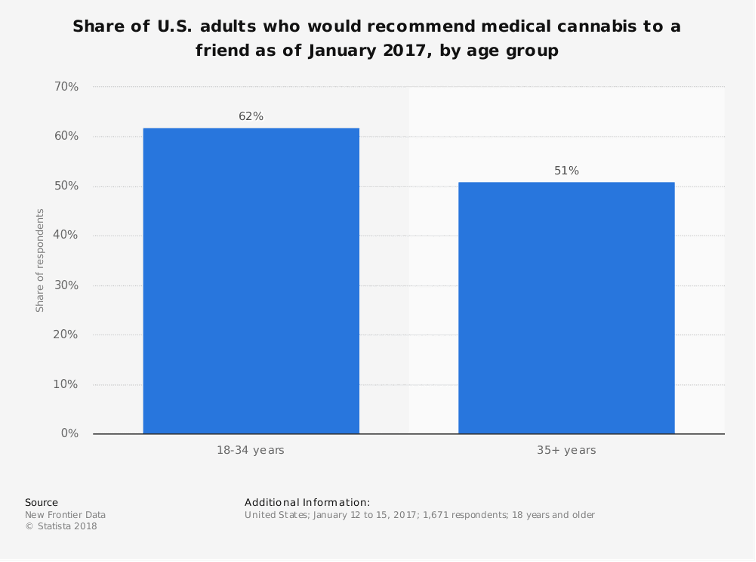
- This statistic displays the annual number of daily doses of prescribed drugs per physician in U.S. states with and without medical cannabis law, as of 2016. According to the data, physicians in states without medical cannabis laws prescribed about 95,672 daily doses of medication annually. Compared to that, the number was significantly lower in states which had a medical cannabis law.
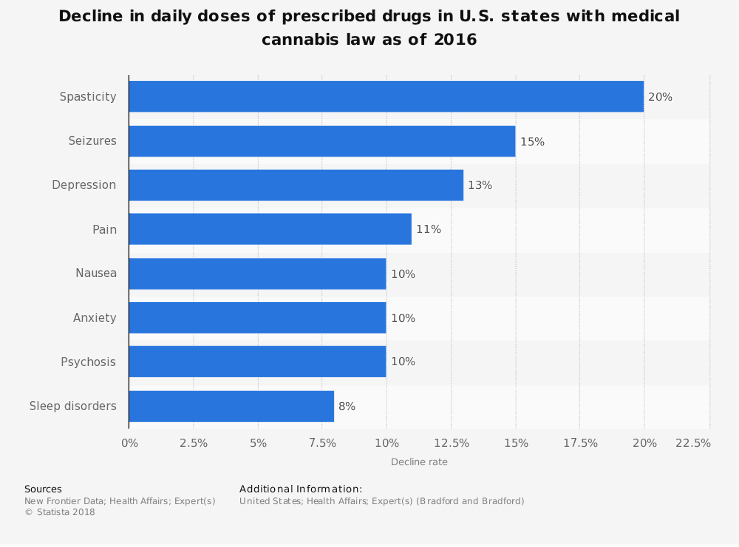
- This graph shows the number of legal medical marijuana patients by U.S. state, per 1,000 state residents, as of May 17, 2018. The state of Colorado had the highest rate of legal medical marijuana patients per 1,000 state residents with 15.86 patients
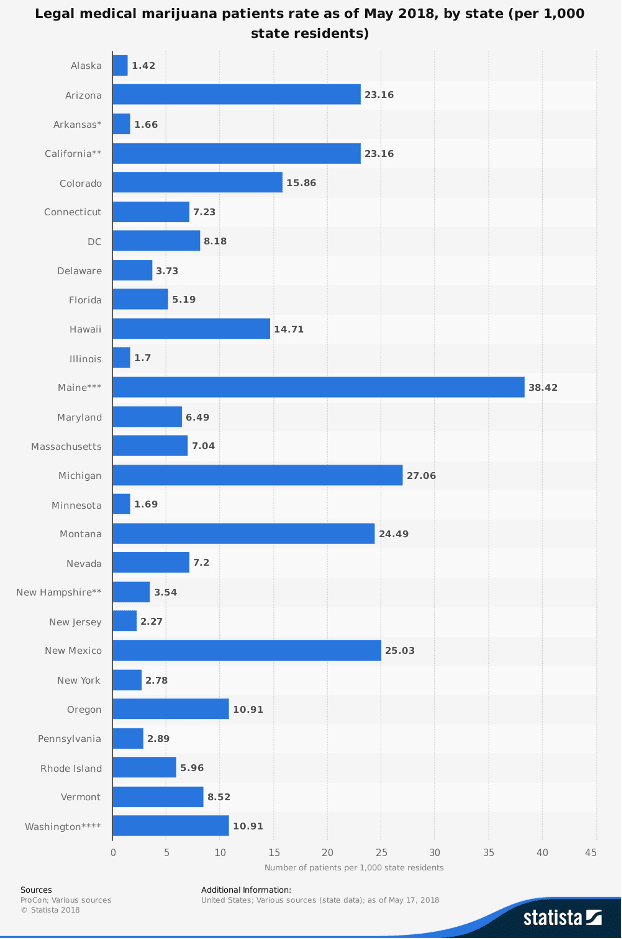
Region: United States
Survey time period: as of May 17, 2018
Supplementary notes…
No data available for: North Dakota, Ohio, West Virginia.
* Arkansas has started issuing medical marijuana registry ID cards, but marijuana is not yet available in the state.
** California had 5,848 registered patients in Fiscal Year 2017/2018, but registration is voluntary and most patients are not registered. We made an estimate using the per capita number of patients in Arizona because of geographical proximity. The Marijuana Policy Project’s (MPP) Feb. 2018 estimate for California, 1,256,550, used Maine’s per capita number of patients.
*** In presenting the number of medical marijuana registration cards printed, Maine’s medical marijuana program website states, “This number is not an accurate reflection of the number of patients as it contains all certifications printed, including misprints, reissue of lost certifications and other anomalies.”
**** Washington listed 32,123 recognition cards created as of May 16, 2018, but registration isn’t required to be a medical marijuana patient except for patients under 18. As a result, we created an estimate based on the per capita patient numbers in Oregon.
* * *
Subscribe to Empowering You Organically
Never miss an episode!
APPLE PODCASTS SPOTIFY GOOGLE PODCASTS
–
Episode 13 – Understanding the Healing Power of Cannabis



